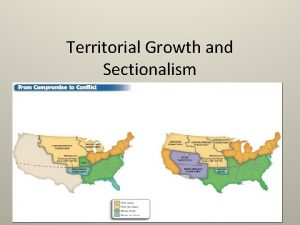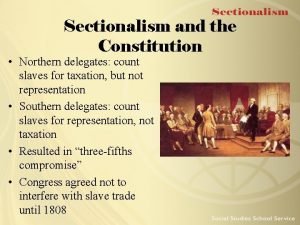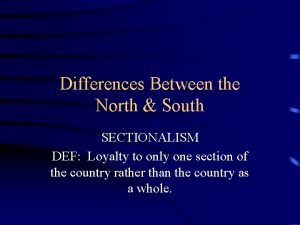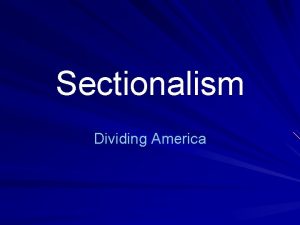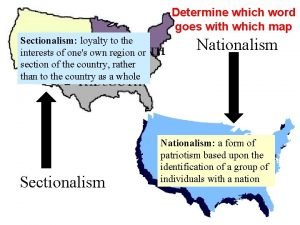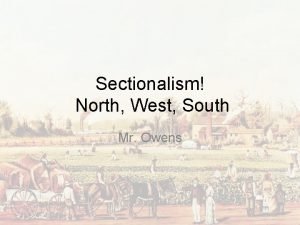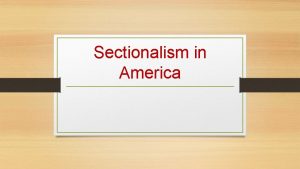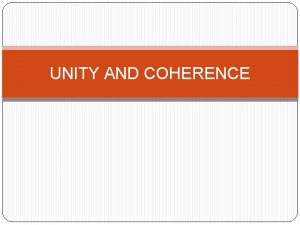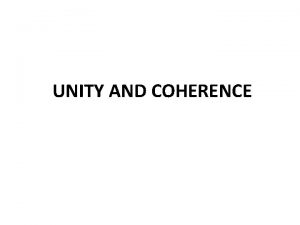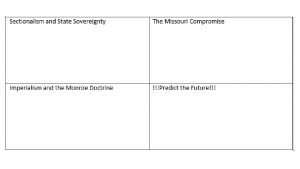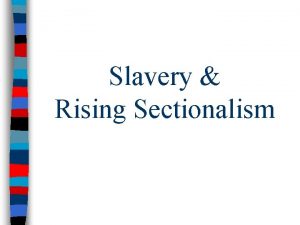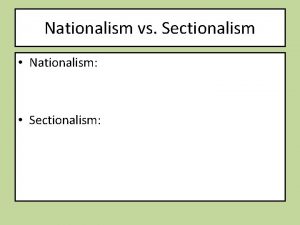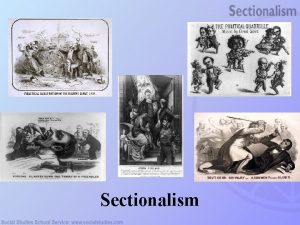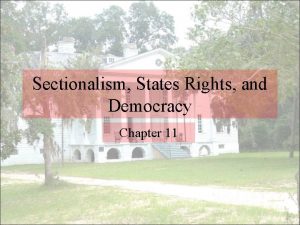Unity Sectionalism 2 The Growth of Sectionalism John



















- Slides: 19

Unity & Sectionalism (2)

The Growth of Sectionalism • John C Calhoun was a planter from South Carolina. • He was one of the War Hawks that called for War with Britain in 1812.

The Growth of Sectionalism • Calhoun favored support for internal improvements and developing industry as well as gaining backing for the creation of a national bank. • He thought these programs would benefit the South.

The Growth of Sectionalism • In the 1820’s John C. Calhoun’s view began to change and emerged a chief supporter State Sovereignty. • State Sovereignty- the idea that states have autonomous power. (acting independently or having the freedom to do so. )

The Growth of Sectionalism • Calhoun then reversed his support for high tariffs. • He argued the tariffs raised the prices on manufactured goods that they could not produce for themselves.

The Growth of Sectionalism • Daniel Webster was first elected to congress in 1812 from New Hampshire. • Webster would later represent Massachusetts in the Senate & the House.

The Growth of Sectionalism • Webster began his career as a supporter of free trade & the shipping interests of New England. • Webster would later support the Tariff of 1816 - which would protect American Interests from foreign competition.

The Growth of Sectionalism • Webster supported policies that he thought would strengthen the North. • Webster also gained fame as one of the great orators of his day.

The Growth of Sectionalism • Henry Clay was another War Hawk from Kentucky. • He would become Speaker of the House in 1811 & a leader who would represent interests of the West.

The Growth of Sectionalism • Henry Clay was also on the delegation that negotiated the Treaty of Ghent ending the War of 1812. • Clay would become the leader known for trying to resolve sectional disputes through compromise.

Missouri Compromise • Sectional tension increased over the issue of admitting new states. • The problem stemmed from slavery. • The South wanted Missouri, part of the Louisiana Purchase, admitted as a slave state.


Missouri Compromise • Northerners wanted Missouri to be a free state. • The issue became a subject of debate throughout the country. • This exposed regional divisions that would poison national politics into the 1850’s and 1860’s.

Missouri Compromise • While Congress was considering Missouri for statehood, Maine, then a part of Massachusetts, applied for statehood.

Missouri Compromise • Statehood expanded to include Maine in the conversation. • Those watching the arguments in Congress feared for the stability & future of the Union.

Missouri Compromise • Henry Clay would work out a compromise that preserved a balance between the North & South.

Missouri Compromise • The Missouri Compromise of 1820 provided for the admission of Missouri as a slave state. • It also provided for admission of Maine as a free state.

Missouri Compromise • The Missouri Compromise banned slavery in the remainder of the Louisiana Territory, North of the 3630 N Parallel.

 What is growth analysis
What is growth analysis Primary growth and secondary growth in plants
Primary growth and secondary growth in plants Step growth polymerization vs chain growth
Step growth polymerization vs chain growth Primary growth and secondary growth in plants
Primary growth and secondary growth in plants Vascular ray
Vascular ray Geometric growth population
Geometric growth population Neoclassical growth theory vs. endogenous growth theory
Neoclassical growth theory vs. endogenous growth theory Difference between organic and inorganic growth
Difference between organic and inorganic growth Slave state
Slave state Nationalism vs sectionalism
Nationalism vs sectionalism West sectionalism
West sectionalism Sectionalism def
Sectionalism def American system apush
American system apush Sectionalism def
Sectionalism def Sectionalism def
Sectionalism def Sectionalism doodle map
Sectionalism doodle map What's the difference between nationalism and sectionalism
What's the difference between nationalism and sectionalism Quiz 3: nationalism and sectionalism
Quiz 3: nationalism and sectionalism Sectionalism
Sectionalism Sectionalism def
Sectionalism def









